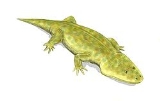
Trematosauria
Encyclopedia
Trematosauria is one of two major groups of temnospondyl amphibians that survived the Permian-Triassic extinction event
, the other (according to Yates and Warren 2000) being the Capitosauria
. The trematosaurs were a diverse and important group that included many medium-sized to large forms that were semi-aquatic to totally aquatic. The group included long-snouted forms such as the trematosauroid
s and short, broad-headed forms such as the metoposaurs
. Although most groups did not survive beyond the Triassic
, one lineage, the brachyopoids
, continued until the Cretaceous
period.
after Yates and Warren (2000):
Permian-Triassic extinction event
The Permian–Triassic extinction event, informally known as the Great Dying, was an extinction event that occurred 252.28 Ma ago, forming the boundary between the Permian and Triassic geologic periods, as well as the Paleozoic and Mesozoic eras...
, the other (according to Yates and Warren 2000) being the Capitosauria
Capitosauria
Capitosauria is a clade of stereospondyl temnospondyls. Capitosauria and its sister taxon Trematosauria are the only major temnospondyl clades that existed during the Mesozoic....
. The trematosaurs were a diverse and important group that included many medium-sized to large forms that were semi-aquatic to totally aquatic. The group included long-snouted forms such as the trematosauroid
Trematosauroidea
Trematosauroidea are an important group of Triassic Temnospondyl amphibians. They flourished briefly during the Early Triassic, occurring worldwide before declining at the start of the Middle Triassic, although the group continued until the Late Triassic. They were medium-sized temnospondyls with...
s and short, broad-headed forms such as the metoposaurs
Metoposauridae
Metoposauridae is an extinct family of trematosaurian temnospondyls. The family is known from the Triassic and Jurassic periods. Most members are large, approximately long...
. Although most groups did not survive beyond the Triassic
Triassic
The Triassic is a geologic period and system that extends from about 250 to 200 Mya . As the first period of the Mesozoic Era, the Triassic follows the Permian and is followed by the Jurassic. Both the start and end of the Triassic are marked by major extinction events...
, one lineage, the brachyopoids
Brachyopoidea
Brachyopoidea is a superfamily of temnospondyls that lived during the Mesozoic. It contains the families Brachyopidae and Chigutisauridae. The earliest records of brachyopids are from the Lower Triassic in Australia...
, continued until the Cretaceous
Cretaceous
The Cretaceous , derived from the Latin "creta" , usually abbreviated K for its German translation Kreide , is a geologic period and system from circa to million years ago. In the geologic timescale, the Cretaceous follows the Jurassic period and is followed by the Paleogene period of the...
period.
Phylogeny
CladogramCladogram
A cladogram is a diagram used in cladistics which shows ancestral relations between organisms, to represent the evolutionary tree of life. Although traditionally such cladograms were generated largely on the basis of morphological characters, DNA and RNA sequencing data and computational...
after Yates and Warren (2000):
External links
- Temnospondyli: Trematosauria at PalaeosPalaeosPalaeos.com is a web site on biology, paleontology, cladistics and geology and which covers the history of Earth. The site is well respected and has been used as a reference by professional paleontologists such as Michael J. Benton, the professor of vertebrate palaeontology in the Department of...
- Trematosauria at Mikko's Phylogeny ArchiveMikko's Phylogeny ArchiveMikko's Phylogeny Archive is an amateur paleontology website maintained by Mikko Haaramo, a student at the University of Helsinki's Department of Geology, Division of Geology and Palaeontology....
(cladogram)

